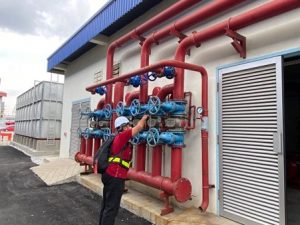Fire Fighting (Control) Systems

AUTOMATIC SPRINKLER SYSTEMS
To extinguish a fire, one of four methods can be used. These methods are:
- Remove the heat.
- Eliminate oxygen or dilute the oxygen concentration in the burning zone.
- Remove the fuel.
- Interrupt the chemical chain reactions
A sprinkler system, as well as any other type of fire control system, must incorporate three basic features for it to be considered a viable means of fire protection. It must (1) detect the presence of a fire and transmit an alarm to the building occupants, (2) confine the fire to the area of origin, and (3) activate without human intervention. The most important fire safety objective is to protect human life. A fire control system achieves this objective by detecting the presence of a fire and transmitting an alarm that warns occupants of a fire’s presence. By warning the occupants, they have sufficient time to safely evacuate a building and summon the fire department. The second most important fire safety objective is to protect property. A fire control system achieves this objective by applying an extinguishing agent that confines the fire to the area of origin. This prevents additional property from being damaged by a fire. Last, fire control systems must be capable of activating during a fire without human intervention. Fire control systems that function without human intervention are termed automatic. Automatic systems, if properly installed and maintained, are highly reliable when required to activate.
SPRINKLER HEADS
The standard sprinkler head provides, at 4 feet below the detector, a discharge covering a diameter of approximately 16 feet when discharging at 15 gallons per minute. Orifice sizes vary but the minimum allowable orifice is ½ inch in diameter. Sprinkler heads can be installed in an upright or downward (pendant) position.
Maintaining adequate clearance below a sprinkler head is important to the effective operation of the sprinkler head. A minimum, 18-inch clearance should be maintained between the top of any storage and a sprinkler detector. If a solid pile of stored material is 15 feet high, then there must be a 36-inch clearance maintained. If loose or palletized storage is 12 feet high, then a 36-inch clearance is required.
WATER SUPPLY
Adequate water supplies are needed for automatic sprinkler systems. Sprinkler systems can be supplied by a variety of methods including a public main, a private storage tank and fire pump, or a private pond or lake and fire pump. Sprinkler systems also incorporate a fire department connection for a fire department pumper to supplement the water supply and pressure if needed. Whatever water supply method is chosen, water supplies must be evaluated prior to designing and installing sprinkler systems. A water supply should only be measured by a professional trained for water supply testing. The water supply evaluation should include a review of the public water supply, including maps of the distribution system showing locations of mains and valves; records of consumption, storage levels, gate valve and hydrant inspections; and an actual measurement of water supply output from the nearest fire hydrants. This information is gathered, and a fire low is calculated. Fire low is the amount of water available for firefighting purposes.
The water supply required for a sprinkler system is termed the demand. A system’s demand consists of the water required for sprinkler systems at the most hydraulically remote area of the system, plus interior hose lines and exterior hose lines. The available fire low must be larger than the system demand.
For more information on Safety Training do click this link to MASMA Safety or click here for more information. Do not hesitate to call us at 019-2000643. MASMA Fire Engineering – Your Trusted Fire Contractor.
